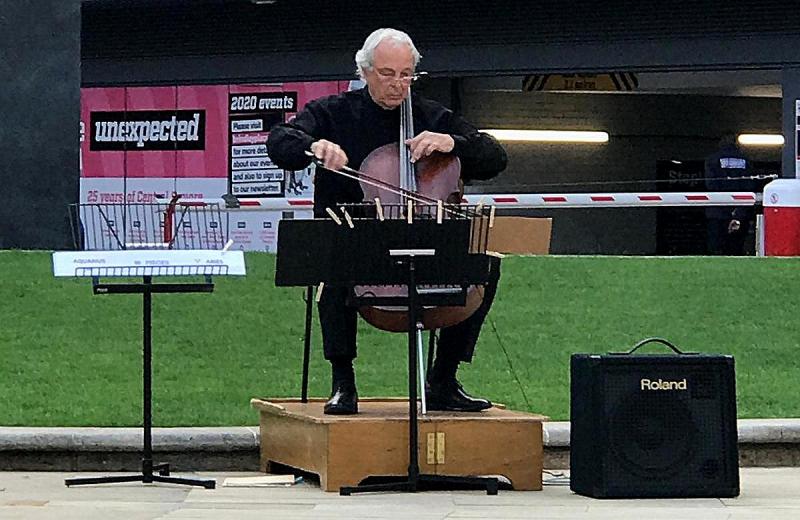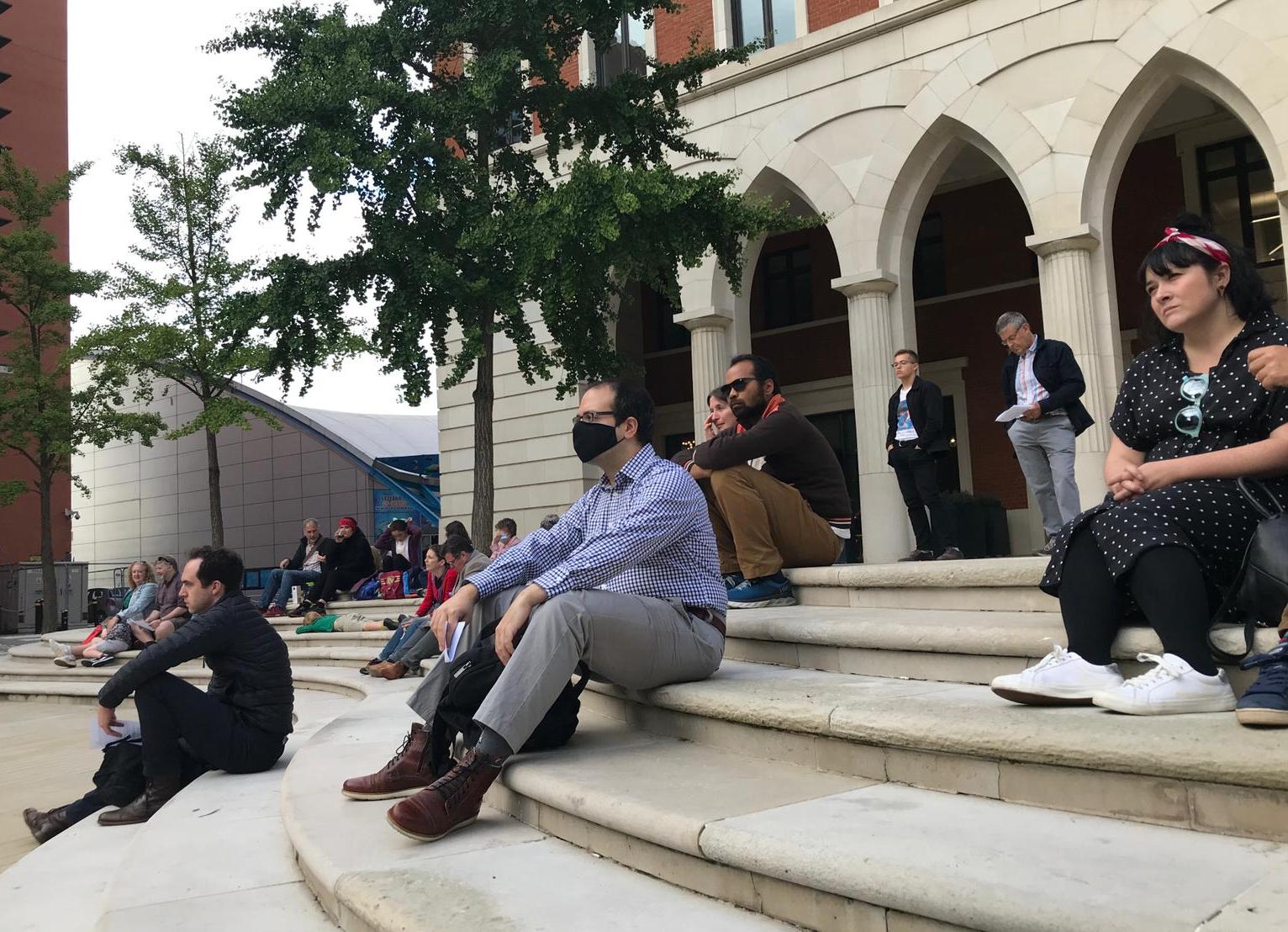BCMG, Heinen, Brindleyplace Birmingham review - from the concrete canyons to the stars | reviews, news & interviews
BCMG, Heinen, Brindleyplace Birmingham review - from the concrete canyons to the stars
BCMG, Heinen, Brindleyplace Birmingham review - from the concrete canyons to the stars
Solo Stockhausen achieves lift off, as live music returns to the Second City

Birmingham emerged from musical lockdown with Stockhausen. It couldn’t have been anyone else, really.
In fact, Birmingham Contemporary Music Group is about to travel to Hanover to participate in another rare performance of Sternklang. This was a sort of prelude to that adventure, planned in collaboration with the Ikon Gallery, and although it involved only one performer, it’s not really possible to describe anything by Stockhausen as small scale. The twelve brief, zodiac inspired melodies of Tierkreis are a lesson in how a single line of music can unlock an entire imaginative cosmology. Performed during rush hour in the central square of Brindleyplace by BCMG’s co-founder, the cellist Ulrich Heinen, they had to contend with the ambient noise of a whole conurbation – yet still managed to make their creator’s outsize personality felt.
It was one of those ideas that was just crazy enough to work. Brindleyplace is Birmingham’s not-particularly-subtle answer to Canary Wharf; a swagger of kitsch 1990s office blocks and chain restaurants plonked around landscaped squares and (currently inactive) fountains. Heinen had set up opposite a shuttered Costa Coffee in the largest square, his cello case propped next to a recycling bin. This open air performance, predicted BCMG’s artistic director in the free programme sheets, "links us back to nature and as Stockhausen puts it, the individual with the cosmic whole, 'preparing us for beings from other stars and their arrival’”.
He wasn’t joking about nature. A flock of seagulls had just hit town, announcing their arrival so enthusiastically that you’d have assumed that a trawlerload of herring had just been landed at Gas Street Basin. Cycle couriers and commuters on Bromptons freewheeled across the performance space, and a police car idled nearby, presumably to deal with unauthorised interplanetary visitors. None of this seemed to fluster Heinen, though even with his cello discreetly amplified, the shimmering textures of Bernd Alois Zimmermann’s Four Short Studies of 1970 – originally commissioned by Heinen’s teacher Siegfried Palm – simply dissolved amid the ambient noise. Henze’s Serenade fared better. There was something about Henze’s fundamental lyricism – the Italianate warmth that underlies its overcast melodies and quizzical gestures – that somehow managed to cut through, especially when carried by Heinen’s mellow but intensely centred tone. He spent great sprays of pizzicato arcing over the empty fountains; droplets of melody ricocheted off the concrete and brick of the surrounding office blocks, and hung in the air along with the car horns and generators.
Henze’s Serenade fared better. There was something about Henze’s fundamental lyricism – the Italianate warmth that underlies its overcast melodies and quizzical gestures – that somehow managed to cut through, especially when carried by Heinen’s mellow but intensely centred tone. He spent great sprays of pizzicato arcing over the empty fountains; droplets of melody ricocheted off the concrete and brick of the surrounding office blocks, and hung in the air along with the car horns and generators.
And then Stockhausen’s cosmic wheel began to spin. The composer supplies only a title and a single line of melody for each sign of the zodiac, though he does suggest that performers play each one at least three or four times before moving on. Heinen followed these instructions diligently, but although he insisted to me after the performance that he’d only added some minor touches of instrumental colour, he inflected each sequence so vividly that they barely seemed like repetitions – more an evolving, almost improvisatory, fantasy on Stockhausen’s pungently-characterised musical symbols.
The lyricism that had carried Henze’s ideas through the urban clamour was redoubled here – and as Heinen moved from Leo (because it’s August) through the chaste melodic gestures of Virgo, the flashing snap-pizzicati of Scorpio and the deep, booming song of Taurus, the imagination took over: with Heinen’s luminous, eloquent cello sound etching musical lines that seemed to glow, multicoloured, against the urban white noise of traffic and passing aircraft. And then he, and Stockhausen, came full circle; the vision faded, and Birmingham dropped softly back into our own universe. The policemen got into their car and drove away.
rating
Explore topics
Share this article
The future of Arts Journalism
You can stop theartsdesk.com closing!
We urgently need financing to survive. Our fundraising drive has thus far raised £49,000 but we need to reach £100,000 or we will be forced to close. Please contribute here: https://gofund.me/c3f6033d
And if you can forward this information to anyone who might assist, we’d be grateful.

Subscribe to theartsdesk.com
Thank you for continuing to read our work on theartsdesk.com. For unlimited access to every article in its entirety, including our archive of more than 15,000 pieces, we're asking for £5 per month or £40 per year. We feel it's a very good deal, and hope you do too.
To take a subscription now simply click here.
And if you're looking for that extra gift for a friend or family member, why not treat them to a theartsdesk.com gift subscription?
more Classical music
 Robin Holloway: Music's Odyssey review - lessons in composition
Broad and idiosyncratic survey of classical music is insightful but slightly indigestible
Robin Holloway: Music's Odyssey review - lessons in composition
Broad and idiosyncratic survey of classical music is insightful but slightly indigestible
 Classical CDs: Wolf-pelts, clowns and social realism
British ballet scores, 19th century cello works and contemporary piano etudes
Classical CDs: Wolf-pelts, clowns and social realism
British ballet scores, 19th century cello works and contemporary piano etudes
 Bizet in 150th anniversary year: rich and rare French offerings from Palazzetto Bru Zane
Specialists in French romantic music unveil a treasure trove both live and on disc
Bizet in 150th anniversary year: rich and rare French offerings from Palazzetto Bru Zane
Specialists in French romantic music unveil a treasure trove both live and on disc
 Scottish Chamber Orchestra, Ibragimova, Queen’s Hall, Edinburgh review - rarities, novelties and drumrolls
A pity the SCO didn't pick a better showcase for a shining guest artist
Scottish Chamber Orchestra, Ibragimova, Queen’s Hall, Edinburgh review - rarities, novelties and drumrolls
A pity the SCO didn't pick a better showcase for a shining guest artist
 Kilsby, Parkes, Sinfonia of London, Wilson, Barbican review - string things zing and sing in expert hands
British masterpieces for strings plus other-worldly tenor and horn - and a muscular rarity
Kilsby, Parkes, Sinfonia of London, Wilson, Barbican review - string things zing and sing in expert hands
British masterpieces for strings plus other-worldly tenor and horn - and a muscular rarity
 From Historical to Hip-Hop, Classically Black Music Festival, Kings Place review - a cluster of impressive stars for the future
From quasi-Mozartian elegance to the gritty humour of a kitchen inspection
From Historical to Hip-Hop, Classically Black Music Festival, Kings Place review - a cluster of impressive stars for the future
From quasi-Mozartian elegance to the gritty humour of a kitchen inspection
 Shibe, LSO, Adès, Barbican review - gaudy and glorious new music alongside serene Sibelius
Adès’s passion makes persuasive case for the music he loves, both new and old
Shibe, LSO, Adès, Barbican review - gaudy and glorious new music alongside serene Sibelius
Adès’s passion makes persuasive case for the music he loves, both new and old
 Anja Mittermüller, Richard Fu, Wigmore Hall review - a glorious hall debut
The Austrian mezzo shines - at the age of 22
Anja Mittermüller, Richard Fu, Wigmore Hall review - a glorious hall debut
The Austrian mezzo shines - at the age of 22
 First Person: clarinettist Oliver Pashley on the new horizons of The Hermes Experiment's latest album
Compositions by members of this unusual quartet feature for the first time
First Person: clarinettist Oliver Pashley on the new horizons of The Hermes Experiment's latest album
Compositions by members of this unusual quartet feature for the first time
 Gesualdo Passione, Les Arts Florissants, Amala Dior Company, Barbican review - inspired collaboration excavates the music's humanity
At times it was like watching an anarchic religious procession
Gesualdo Passione, Les Arts Florissants, Amala Dior Company, Barbican review - inspired collaboration excavates the music's humanity
At times it was like watching an anarchic religious procession
 Classical CDs: Camels, concrete and cabaret
An influential American composer's 90th birthday box, plus British piano concertos and a father-and-son duo
Classical CDs: Camels, concrete and cabaret
An influential American composer's 90th birthday box, plus British piano concertos and a father-and-son duo
 Cockerham, Manchester Camerata, Sheen, Martin Harris Centre, Manchester review - re-enacting the dawn of modernism
Two UK premieres added to three miniatures from a seminal event of January 1914
Cockerham, Manchester Camerata, Sheen, Martin Harris Centre, Manchester review - re-enacting the dawn of modernism
Two UK premieres added to three miniatures from a seminal event of January 1914

Add comment